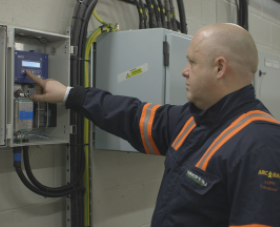Innovation update February 2017
Innovation update - February 2017
Welcome to the third issue of our quarterly e-newsletter, Innovation Update. This regular update will provide you with the key highlights from our innovation portfolio. We hope you find it of interest.
Top CLASS project gets the go ahead

In January our board gave the go ahead for our award-winning CLASS project to be adopted into business as usual, which could save our customers around £100 million over the next 25 years – and £300 million across Great Britain.
As part of the original CLASS project, we have already proved that ‘automatic voltage controllers’ (AVCs) can be used to reduce demand for electricity, without customers noticing a difference to their service. In February we will announce the award of a contract to provide enhanced AVCs for 260 of our primary substations.
Head of Commercial Innovation Tony McEntee said, “We are always looking at ways we can use new technology to improve service for our customers. This ground-breaking approach can be used to help National Grid balance supply and demand for the whole of Great Britain. This means we will be less reliant on expensive coal-fired power stations, which is great news for all electricity customers.
“We’ll start to install the enhanced AVCs in the spring, test them during the summer, ready for go live in the autumn.”
The original £9 million CLASS project trialled AVCs at 60 substations which serve 485,000 of our customers. During the 12-month trial we carried out detailed research to make sure customers didn’t notice a change in their electricity supply.
Halfway along Smart Street

This month sees the halfway point of our Smart Street trials. The £11.5 million project is trialling innovative voltage control techniques to enable our networks and customers’ appliances to perform more efficiently and make it easier to adopt low carbon technologies onto the electricity network.
The trials began in January 2016 and will take place over a two-year period which means we can compare one year’s worth of Smart Street data with normal network operation. This will enable us to calculate the overall benefits of Smart Street and understand any impact on the 67,000 customers served by the trial circuits in Manchester, Wigan, Wigton and Egremont.
Since the trials went live we have been extracting system data which is passed to our academic partners for analysis. Next month we will publish our initial academic reports which will assess the benefits of the Smart Street techniques and suggest possible modifications based on the first 12 months of data. We will also publish our first reports on the carbon impact and the cost benefit analysis of Smart Street compared to traditional reinforcement methods. Early findings from the reports indicate that Smart Street will deliver energy savings by stabilising and reducing voltage but without impacting power quality.
A key hypothesis of Smart Street is that customers will not perceive any change in their electricity supply as a consequence of the trials. This month we are conducting a series of focus groups with customers in each trial region to understand whether customers have noticed any changes in power quality since the trials began. Further focus groups will take place after the trials are completed. We will publish a detailed report of our findings in April 2018.
At the end of February we are hosting a technical workshop to update our stakeholders on our progress. Delegates at the workshop will be able to see the Smart Street system in action and visit technology installations to see how Smart Street equipment integrates with the existing network.
Survey starts to show real Value of Lost Load

Electricity supply interruptions have financial and social impacts on customers which vary by season, time of day, customer load and customer type. Understanding the value of lost load (VoLL) is important in network planning and investment strategy and will become increasingly important as customers become more reliant on electricity in the low carbon future.
Through a programme of engagement with a comprehensive range of domestic customers and small to medium enterprises (SMEs), this Network Innovation Allowance (NIA) project will deliver a greater understanding of VoLL by customer segment. The biggest challenge of this research is to understand how this value is likely to change in the future, with greater dependency on electricity.
We have recently carried out a pilot customer survey before rolling it out on a larger scale. Our analysis of the pilot shows that the survey is effective, easily understood by customers and will provide a credible measure of VoLL now, and an indication of how values might change in the future. Early indicators show distinct variations in VoLL across a broad spectrum of customers.
We have now begun the large scale survey which will be conducted in two stages to ensure we capture seasonal variations; the survey involves over 6,000 interviews with electricity consumers from across the whole of Great Britain.
The VoLL project runs from October 2015 – January 2018, culminating in a comprehensive assessment of how VoLL should be defined across a range of customer segments and how this revised model will help DNOs better plan their network investment and customer strategies. The lessons learned and implementation recommendations will be documented in a final report which will be submitted to Ofgem in January 2018.
Innovation events
- Smart Street workshop, 28 February 2017 – opportunity to observe a live demonstration of the Smart Street method at our control centre, visit technology installations and hear about the progress of the Smart Street trials
- Future Networks Conference, 21 March 2017 – Utility Week’s flagship event for innovative & forward-thinking energy networks professionals, featuring our networks strategy & technical services director, Paul Bircham
Useful links
You can find out more detailed information about all of innovation projects using the following links:
- Our new innovation strategy published in March 2016: www.enwl.co.uk/class
- Our LCN Fund project Smart Street: www.enwl.co.uk/smartstreet
- Our LCN Fund project Respond: www.enwl.co.uk/respond
- Our NIC project Celsius: www.enwl.co.uk/celsius
- Our NIA project Value of Lost Load: www.enwl.co.uk/voll
- Our other NIA projects: www.enwl.co.uk/nia
- Meet the Electricity North West innovation team: Meet the team
- The Electricity Networks Association smarter networks portal: www.smarternetworks.org
Or contact us at innovation@enwl.co.uk